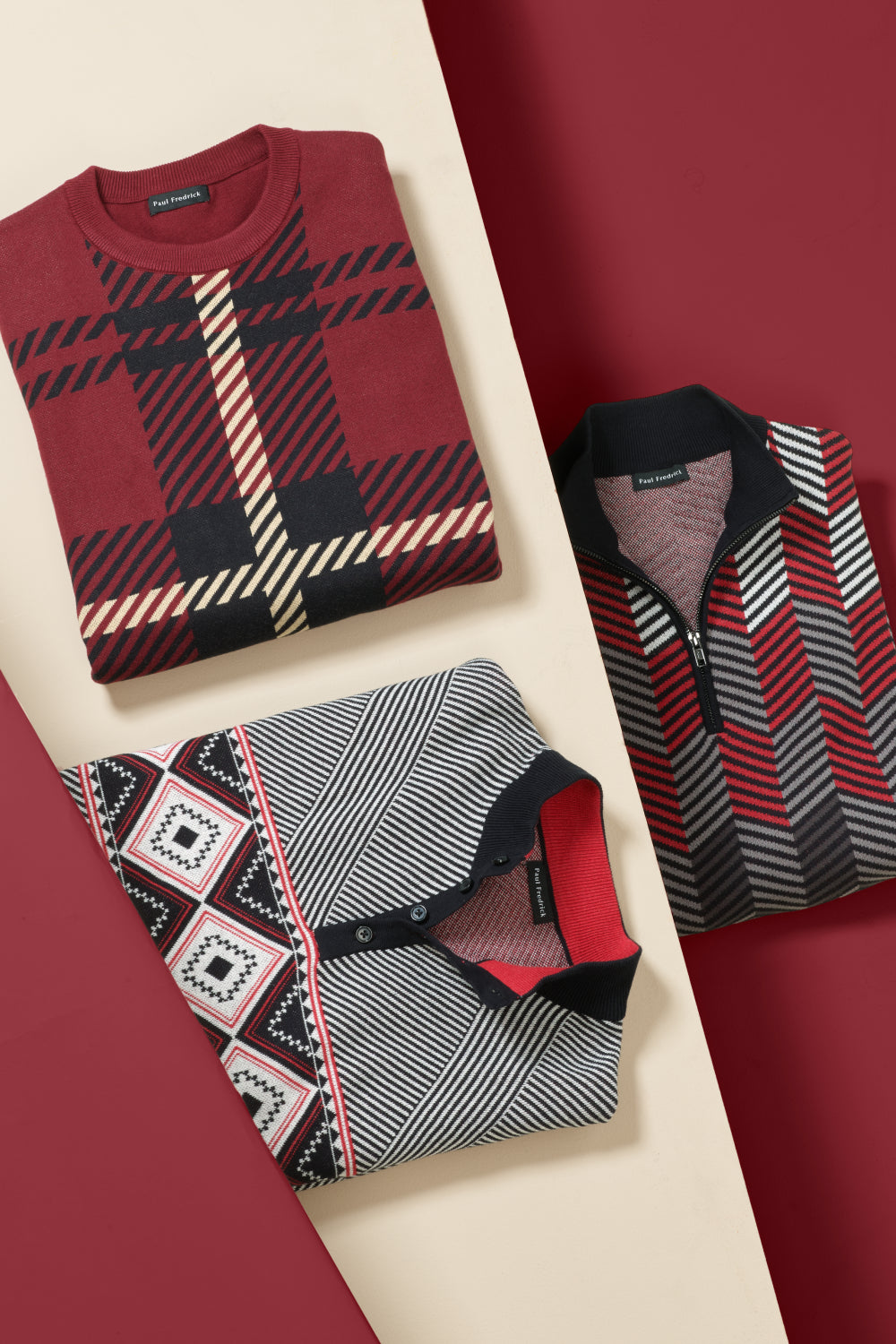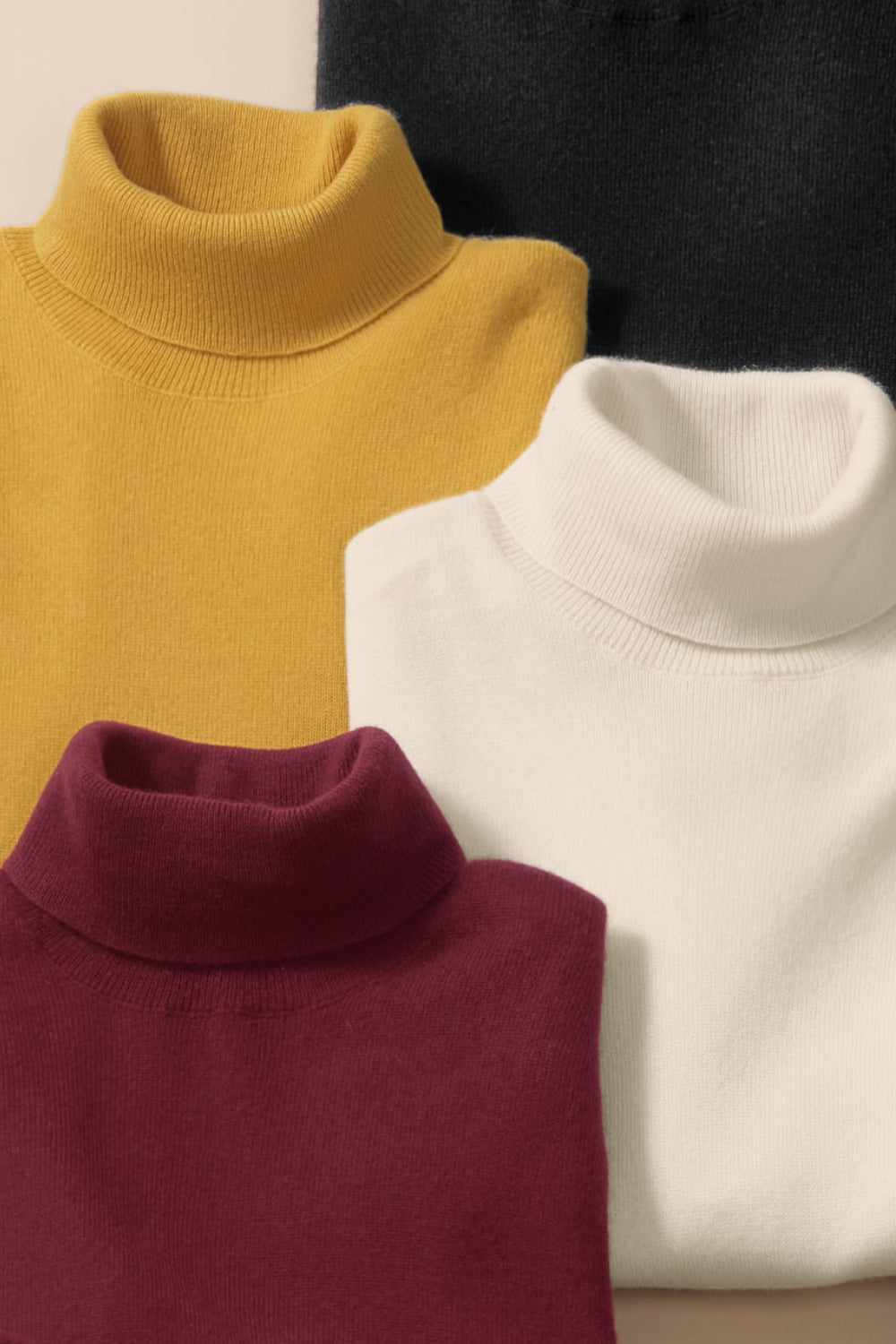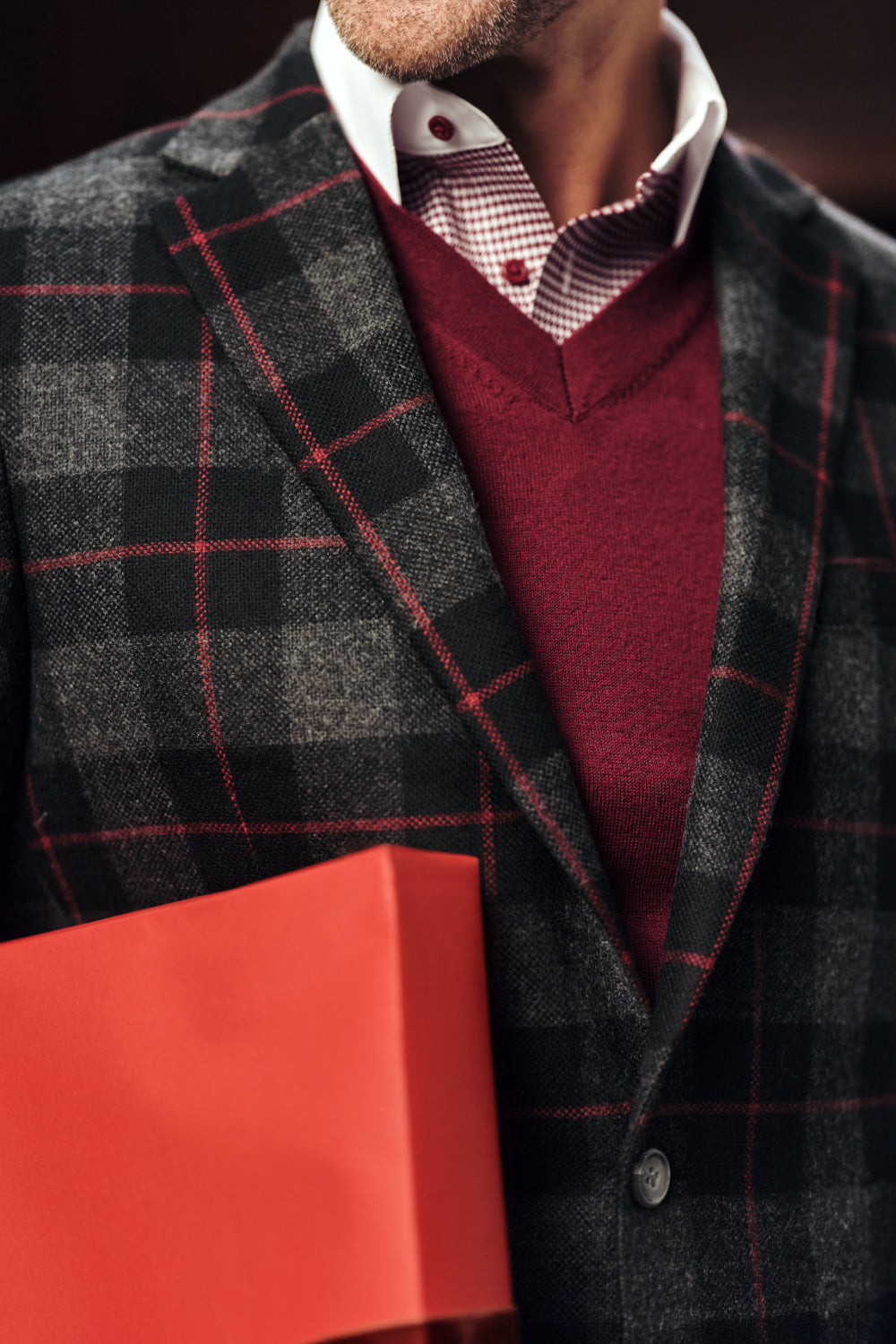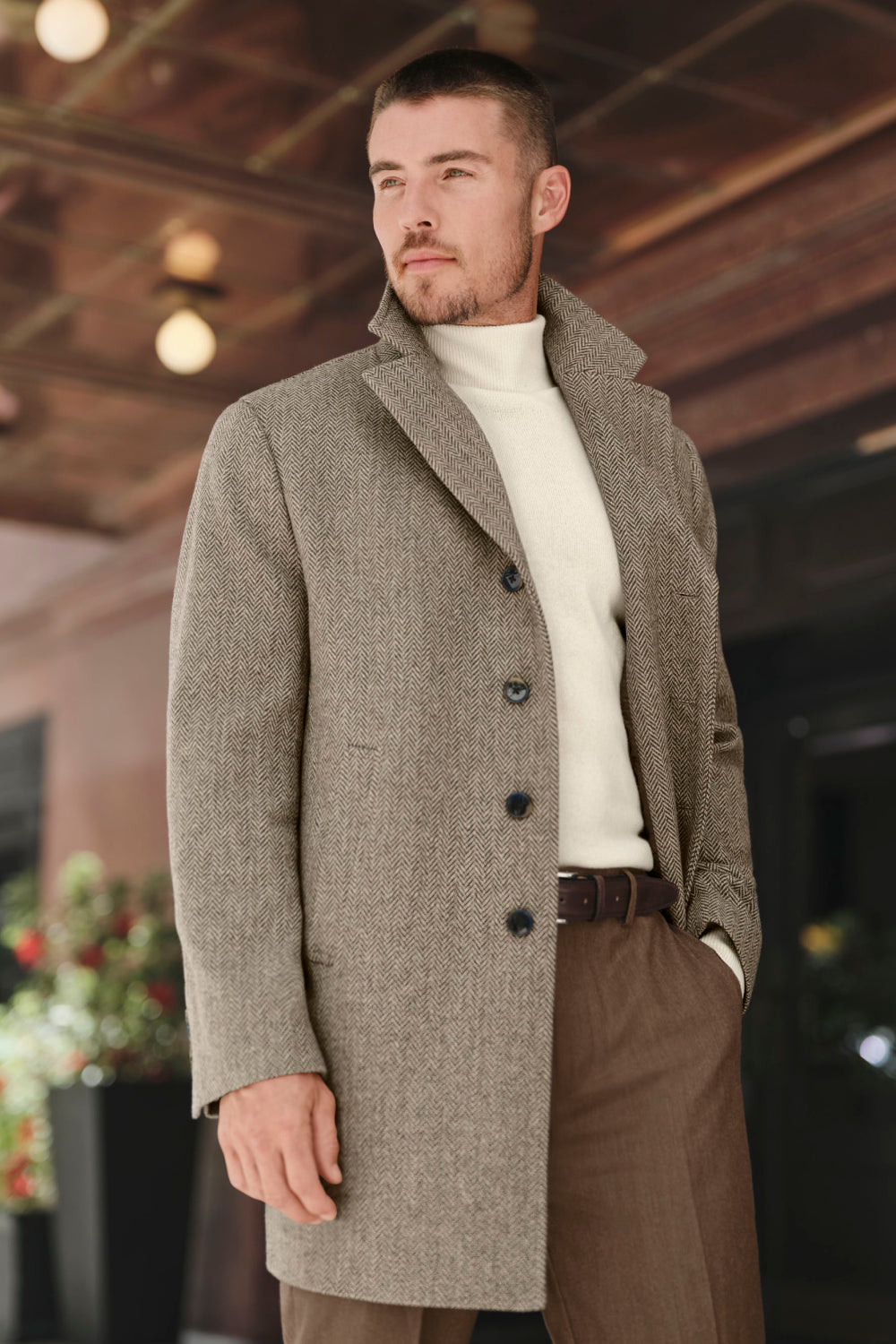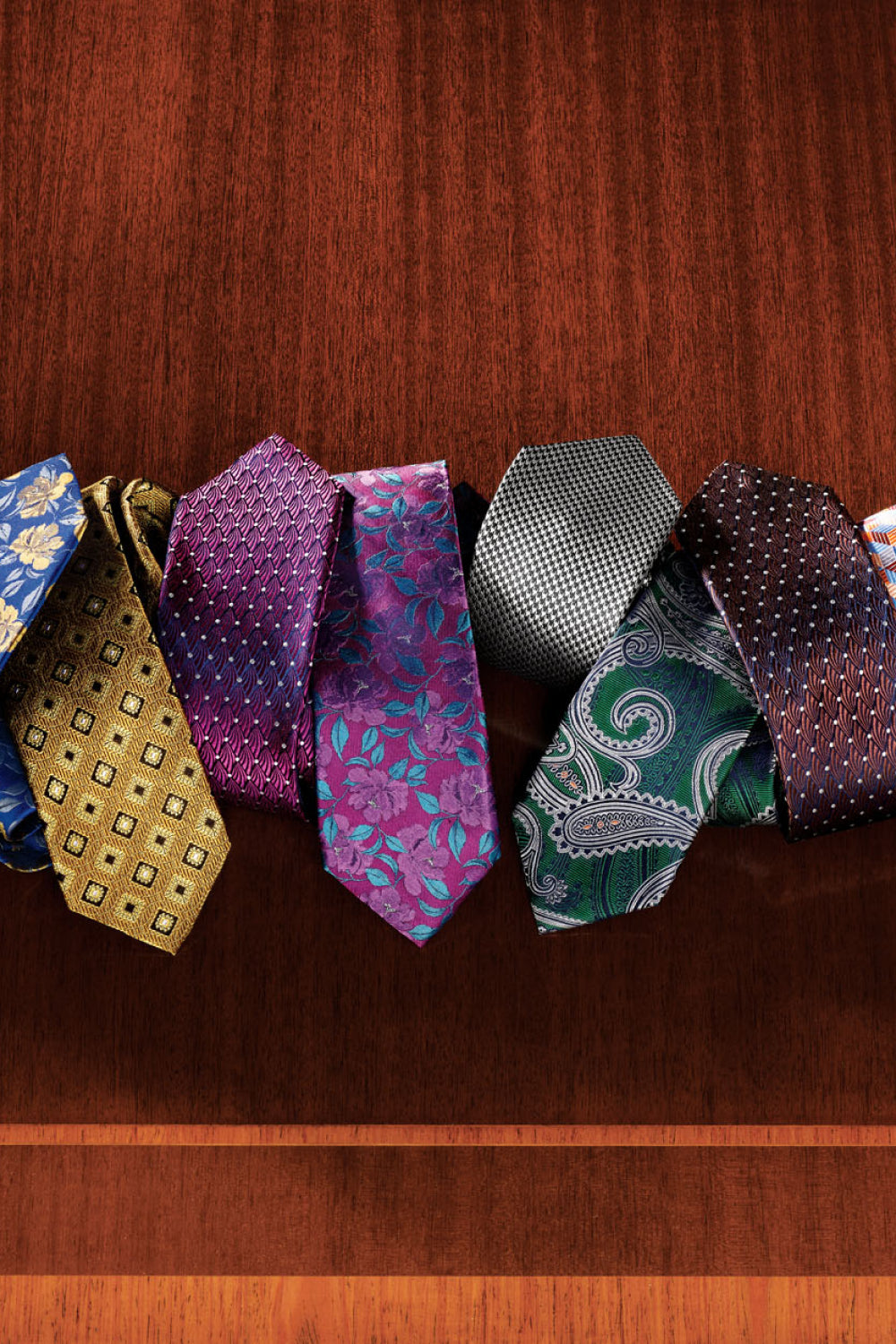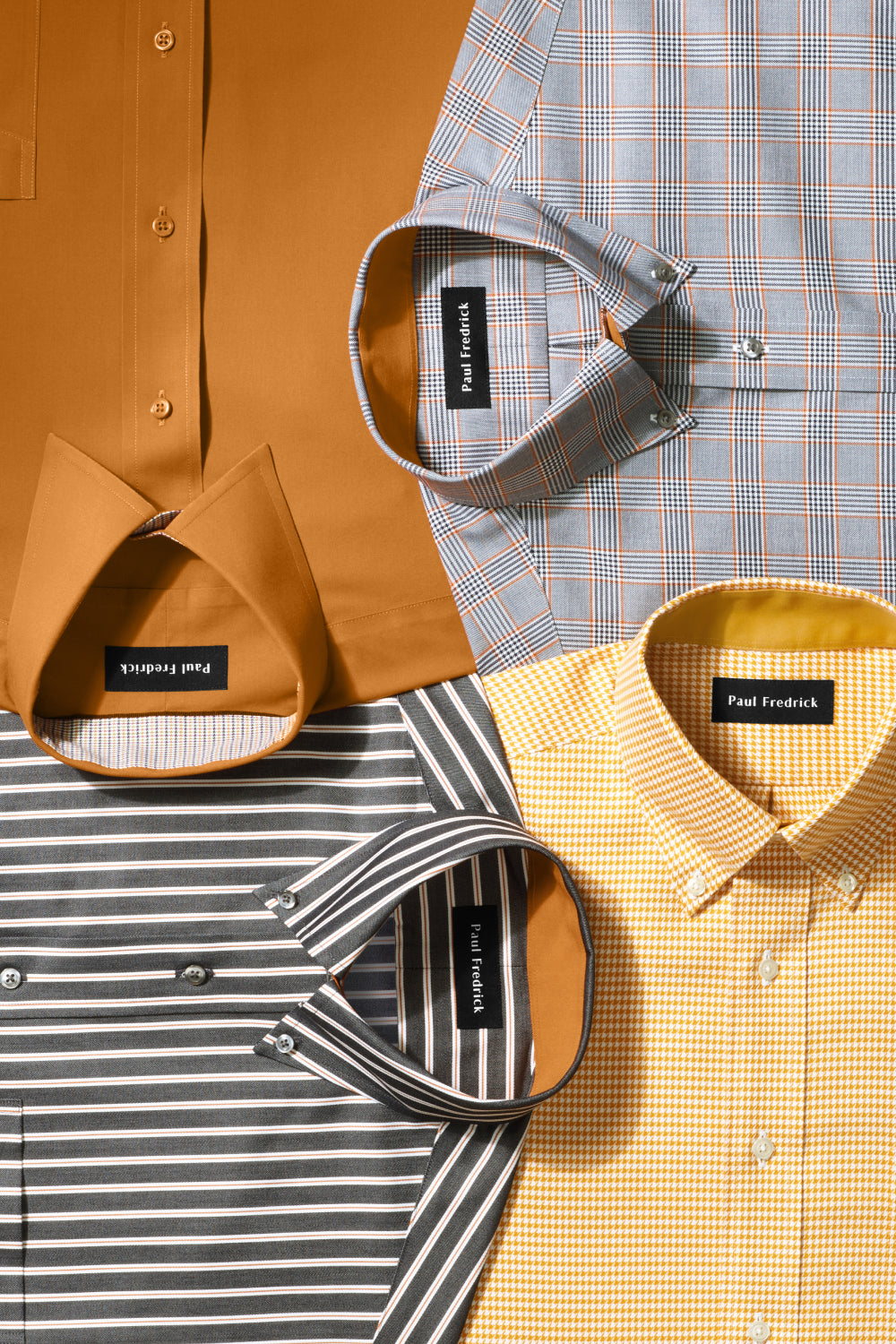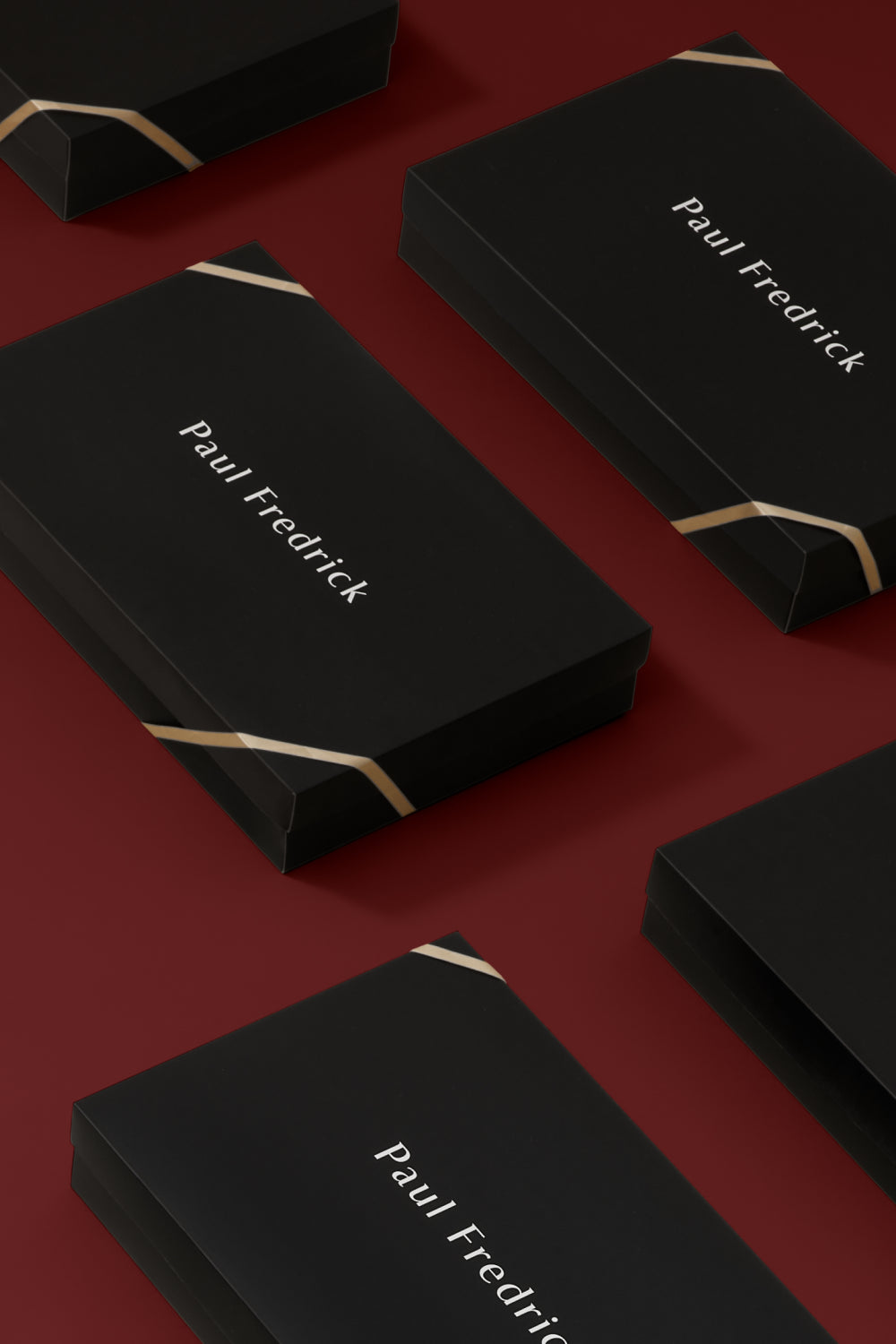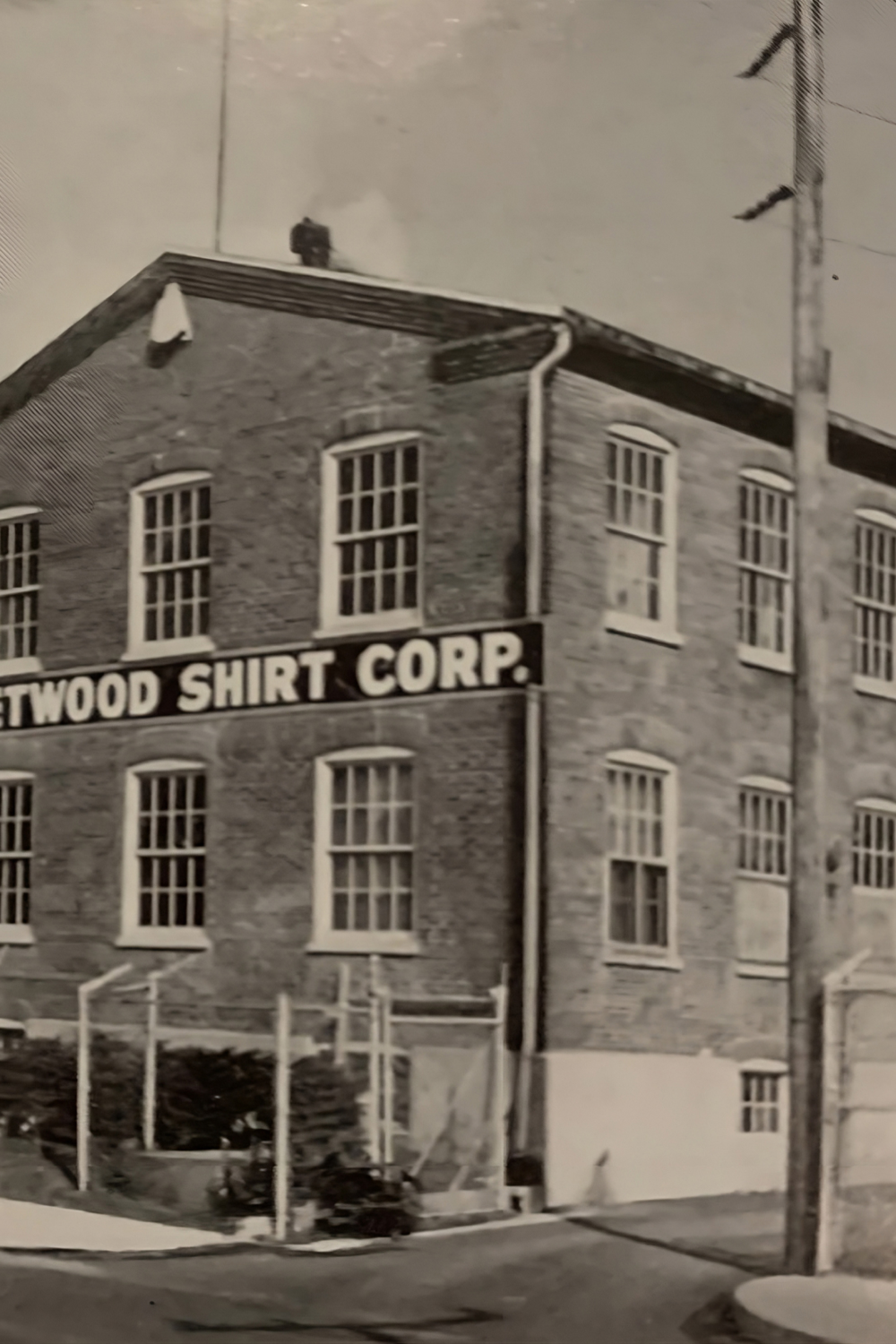Button Down or Button Up Shirts: What's the Difference?
Chances are, you already have button-up and button-down dress shirts in your closet. But do you know which is which? When it comes to dress shirts, many use the terms “button-up” and “button-down” interchangeably. However, these terms refer to two different styles of shirts. Understanding the difference between the two can help you choose the right shirt for the occasion to ensure you look your best.
In this article, we’ll explore the differences between button-up dress shirts and button-down dress shirts—and show you how Paul Fredrick elevates these wardrobe staples to the next level.
What is a Button Up Shirt?
First, let’s talk about the button-up shirt. It’s a classic dress shirt with a placket that buttons up the front (aptly named), giving it a polished look appropriate for a range of settings—everything from a smart casual date night to a suit-and-tie dinner. Button-up shirts feature a variety of collar styles, including the traditional point collar, elegant spread collar and the button-down collar, but we’ll get to that in a second. A button-up shirt can be worn under a sweater, goes great with a tie and is the perfect complement to an elevated sport coat.
Paul Fredrick’s collection of non-iron button-up shirts come in a variety of styles and fits, including Classic, Slim and Tailored, ensuring a perfect fit for almost every body type. Made from high-quality cotton materials, these shirts are designed to make you look and feel your best.
Shop Button Up ShirtsWhat is a Button Down Shirt?
The button-down shirt, often associated with the classic Oxford shirt, is actually a type of button-up shirt with one distinguishing feature: small buttons at the collar points. These buttons are designed to fasten the collar to the shirt, preventing it from shifting out of place. This style originated from polo players in the late 1800s, who needed a way to keep their collars from flapping around during matches.
Button-down shirts can be worn with or without a tie, depending on the occasion. They are often worn as part of business casual dress or paired with casual pants or jeans for a more relaxed look. We offer a range of non-iron button-down shirts, from the classic Oxford button-down to refined 2-ply cotton button-down shirts in a range of colors and patterns. Our attention to detail, from the quality of the fabric to the precision stitching, sets our button-down shirts apart from the rest.
Shop Button Down ShirtsThe Differences Between Button Down and Button Up Shirts
A men’s button-up shirt will typically feature 7 total buttons (plus 2 extra buttons on the collar if you’re wearing a button-down). These buttons will be on the right side of the shirt when wearing the garment.
Collar Type
A button-down collar will always include a button on each side. These buttons can either be hidden or showing. You can pair our button-down shirts with or without a tie depending on the occasion and your personal style.
Button-up dress shirts, on the other hand, are available in a variety of collar types (many of which you will find right here at Paul Fredrick):
- Point Collar: The most common type of collar, the point collar, features a narrow spread between the collar points. This classic collar style is versatile and works well with any tie knot.
- Spread Collar: The spread collar features a wider distance between the collar points than a point collar. This collar type works best with wider tie knots and is ideal for men with broader faces.
- Tab Collar: The tab collar features a small tab that fastens the collar points together, creating a neat and streamlined look. This collar works well with narrow tie knots and adds a touch of sophistication to any outfit.
- Club Collar: The club collar has rounded edges instead of pointed edges, giving it a unique and vintage-inspired look. This collar type is ideal for men with smaller faces and pairs well with a bow tie.
- Band Collar: The band collar stands up and doesn’t fold over. This collar type is perfect for a casual or contemporary look and pairs well with a blazer or sweater.
Paul Fredrick gives a special touch with contrast trim accents lining the inside of the collar—you also find these details on the placket and cuffs of nearly all of our shirts. Complimentary or contrasting colors and patterns add a touch of elegance and sophistication to any outfit.
Fabric Type
We pride ourselves on using high-quality fabrics that not only look great but also feel comfortable and durable. Here are some of the more common fabrics we use for our button-up shirts.
- 100% Cotton: Our button-up shirts are primarily made from 100% cotton, which is known for its breathability, softness and durability. We use premium 2-ply cotton for our non-iron dress shirts. This comfortable, durable fabric gives a great look that holds up to regular wash and wear.
- Linen: For a more relaxed feel, we offer button-up shirts and button-down shirts made from linen, a lightweight and breathable fabric that’s perfect for warm weather. Linen typically has a textured look that adds dimension to any outfit and is ideal for a laid-back weekend, but our linen non-iron dress shirts offer a refined take on this breezy fabric.
- Oxford cloth: Oxford cloth is a classic fabric that’s known for its durability and versatility. It has a unique texture that’s perfect for casual or business casual settings, and it’s also great for layering. We offer a range of Oxford button-up shirts that are perfect for any occasion.
Each fabric has unique properties to suit the situation and your personal taste. With a focus on quality and comfort, you can trust that any shirt from Paul Fredrick pairs a great look with great feel for all-day style and comfort.
When to Wear Button Down vs Button Up Shirts
For the brief answer, a button-up dress shirt is appropriate in many situations, whether button-down collar or some other style. Button-down collar and point collar button-up shirts, in particular, are both versatile garments, adaptable and appropriate regardless of the dress code. Because of this, the nuances of knowing when to wear a button-up shirt versus a button-down shirt can be confusing. What follows are a few simple guidelines to make the right choice for any occasion.
As detailed earlier, button-up shirts come in a variety of collar styles, some that look best with a tie (e.g. the spread collar) and some with or without a tie (e.g. the point collar) Button-up dress shirts with a more formal approach tend to use finer fabrics for a crisp and polished appearance that will fit right in at:
- Weddings
- Job interviews
- Business meetings
- Formal events
- Dressy dinners or parties
- Date nights
On the other hand, button-down shirts show their versatility in a variety of environments. In comparison to other button-up shirts, button-downs are equally appropriate for work, job interviews and business meetings, date night and some (if not most) weddings and other events. However, due to their ability to dress down with ease, the button-down shirt is also great for:
- Brunch with friends
- Business casual events
- Smart casual events
- Cocktail hour
- Cookouts
- Running errands
How to Wear Button Down vs Button Up Shirts
Button-up and button-down shirts can be worn for different occasions and allow for flexibility in style. It’s easy to layer them with blazers, jackets, dress pants, jeans and shoes to create a polished and stylish look that suits your personal panache. Here are a few examples of how to wear each type of shirt.
How to Wear Button-up Shirts
- Formal Occasions: For formal occasions, wear a dress shirt in a solid color or subtle pattern paired with a suit or blazer and dress pants. A classic point or spread collar shirt pairs well with a tie. Finish off the outfit with dress shoes, a belt and cufflinks.
- Business Casual: For a business casual office outfit, pair a dress shirt with dress pants or chinos and a sport coat, blazer or sweater. Add a belt and dress shoes or loafers for the finishing touch.
- Casual Occasions: For a casual occasion wear a dress shirt with jeans or casual pants and sneakers. Try a dress shirt made from a textured fabric like linen or twill for a more laid-back look. Experiment with colors and patterns for an ensemble with personality.
How to Wear Button-down Shirts
- Casual Occasions: Button-down shirts are perfect for casual occasions like brunch with friends or a day out running errands. Wear a button-down shirt untucked (best when the shirttail is of a shorter length) with jeans or casual pants and sneakers or loafers. For a more polished look, tuck the shirt in and add a belt.
- Business Casual: For workday wear, pair a button-down collar shirt with dress pants or casual pants and a sport coat or sweater. Try a button-down collar shirt made from textured fabric like Oxford cloth for a more casual yet put-together look.
- Formal Occasions: Dress up the button-down with dress pants, like wool gabardine slacks, and a blazer or sport coat. Add a tie for a more classic bent. Wear with an open collar under a tailored suit for a modern look that remains appropriate.
FAQ
What is the main difference between a dress shirt and a button up shirt?
A dress shirt is a type of button-up shirt that is specifically designed to be worn with a suit or dress pants in formal or business settings. It typically features a stiff collar and cuffs and is made from high-quality materials like 100% cotton. “Button-up” is a more general name that refers to any shirt that has buttons up the front, regardless of its formality or intended use (dress or casual).
Can you wear a button up shirt untucked?
It depends on the style of the shirt and the occasion. Some button-up shirts are designed to be worn untucked, while others are meant to be tucked in. Casual button-up shirts made from textured fabrics like linen or chambray can be worn untucked with jeans or casual pants for a relaxed look. Dress shirts with a longer tail and a slimmer fit are designed to be tucked in and worn with dress pants or a suit for more formal occasions.
Can you wear a button down shirt with a tie?
Yes, you can wear a button-down shirt with a tie. Button-down collar shirts are considered less formal than point collar or spread collar shirts, but they can still be worn with a tie for a polished look. Choose a tie that complements the color and pattern of the shirt and wear it with a suit or dress pants for a more formal occasion.
Are button down shirts more versatile than button up shirts?
Both button-up and button-down shirts are versatile and can be worn for a range of occasions. Button-down shirts are often seen as more casual, but both button-down and button-up shirts can be dressed up for formal events. A variety of fabrics, colors and fits opens up versatile ways to wear these shirts.
Which one is more formal – button-up or button-down shirts?
Generally, button-up shirts (at least the ones you would otherwise call a dress shirt) are considered more formal than button-down shirts. Button-up shirts with point collars or spread collars are often worn for formal events like weddings or job interviews. However, a button-down shirt made from high-quality fabric can also be dressed up for formal occasions.
Why do button-down shirts have buttons on the collar?
Button-down shirts have buttons on the collar to keep the collar points in place and prevent them from flapping around. This design feature was first introduced in the 19th century by a British polo player who wanted a way to keep his collar in place while riding.
Are button-down shirts considered casual?
Button-down shirts can be worn in a variety of settings from casual to formal. However, because of their sporty origins and the fact that they have a more relaxed collar than others, they are generally considered to be one of the more casual dress shirts.
Can I wear a button-up shirt for business casual?
Yes, a button-up shirt can be worn for business casual, depending on the type of button-up shirt and how it is paired with other clothing items. For example, a button-up dress shirt can be worn with dress pants or chinos for a business casual look.
Do I always have to button the collar buttons of a button down shirt?
It's recommended to always button the collar buttons on a button-down shirt. This helps keep the collar in place and gives the shirt a neat, polished appearance. However, some people choose to leave the collar buttons unbuttoned for a more relaxed look. If wearing a tie, the collar should always be buttoned.
Do you button the bottom button on a shirt?
In general, you should not button the bottom button on a shirt. This is a fashion rule that has been in place for centuries, and while its origins are not entirely clear, it is thought to have something to do with comfort and ease of movement. However, some modern shirts are designed to be worn with the bottom button fastened, so it's always a good idea to check the garment care instructions or consult with a stylist.
Conclusion
In conclusion, the difference between button-up shirts and button-down shirts is the collar. Button-up shirt refers generally to all shirts with a full button front, regardless of collar. Button-down shirts feature a specific collar with buttons at the points. There are many styles of button-up shirts, from casual to dress, with certain qualities and collar types skewing towards the formal. Button-down shirts feature a less stiff collar that easily transitions between casual and dress with a distinct Ivy League vibe. By understanding the differences between these two styles of shirts, you can make informed choices about what to wear for any occasion.







